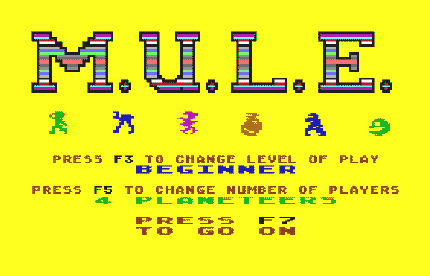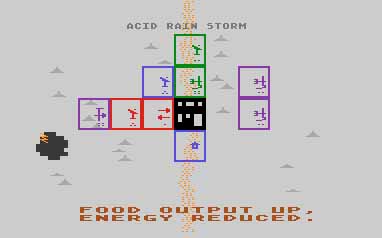Yesterday was another fullish day, as usual. I drove my car for the first time since before Sachet left for Canada (that was fun!) and took it in for an oil change on the way to school. I messed about on campus for the day, photocopying and prepping lessons, and made it home (through traffic, ugh) in time to take a walk with Otis while the sun was shining bright.
Last night, we had a belated birthday celebration for J-Force, hosting her and new beau T-square for tea and port and peach champagne and strawberry shortcake (how genteel!).
Now, it’s time to have a good time.
After I posted those funky maps the other day, Yojimbo commented with an obscure reference to “Mule.”

M.U.L.E., as it is more properly known, was an early computer game from Infocom / Electronic Arts that I had for my Atari home computer. Back in the day when Yojimbo and I were each married to people who are now no longer our wives, and he was an overworked commercial producer, and I was a rookie cop, and our wives worked together in insurance, we somehow regularly found time for the four of us to crowd around the television set in my 600-square foot studio condo in Belltown-before-it-was-cool and play this digital version of a board game. I remember buying two extra joystick controllers to supplement the two that had come with the unit and all of us lined up on the couch with wires trailing to the set. It made it hard to get up and down for coffee or to pee, but we managed. Oh, and at any time, at least three of us were smokers, so you can add that to the ambiance.
The game itself was a little bit of Monopoly, mixed with the seeds of stuff like Sim City, with a few instances of actual hand-eye coordination and joystick control necessary. The scenario was that each player of four (the computer would take over a player if there were not enough people) was a settler on the planet Irata and the goal was to have the most successful settlement, while still ensuring that everyone survived enough for the whole colony to survive. So, there was no destroying your opponents – you needed them alive to buy your stuff and to validate your success.
Each round would begin with a land grant – a marker would move across the map of the area and each player would click to "claim" a plot. Each land area produced the three resources – food, energy, and ore – in different quantities, and you needed a good mix to be successful. There were also advantages to having contiguous plots, so there was competition to pick spots, and the quicker trigger usually won.

After everyone had picked a plot, there would be a sequence of timed plays in which each player “improved” the plot. This involved guiding your little icon-creature into town to buy and outfit a M.U.L.E. – a multiple-use labor element, the robot that worked your land for you – and lead him to the correct plot, all with the joystick. If you weren’t good at screen play you could screw up: the M.U.L.E. would run away and you would be out of luck. If you were good at it, you might be able to outfit and place two or three units and still have time to get back into town to visit the saloon and win money (the equivalent of passing go).
After each player had had a chance at improving their property, the game would have a sequence where stuff happened – the food grew, the energy energized, and the ore got mined. These processes could be affected by random events that favored one product over another.
This display was followed by a sequence showing the players how much of each product they had used and developed in the p[revious round. After the exposition, there was an auction to redistribute the goods. Players with surplus food, for example, would position themselves as sellers, and the hungry players would have to buy from them. These transactions took place graphically in a system that I always imagined as sellers and buyers dancing to meet at a spot in a path that indicated the agreed-upon price. Some people would profit, some would scrape buy, and the sequence would start again.
After ten rounds, the computer determined whether the colony had survived and which settler was the winner.
For a simple little bit of programming, it was surprising sophisticated and engendered all sorts of backstories and emotional responses from the people controlling the little creatures – well, at least from us, anyway. We played it over and over for hours and hours, and I never remember getting bored.
Doing a little research for this post, I found some cool stuff:
There is, of course, a little M.U.L.E. subculture to be found on the web, and it was a real award-winner in its day.
You can still play M.U.LE. with an online emulator – and you can play other people over the intarweb! (Go here just to hear the cool theme music.)
The games primary designer, Dani Bunten, has been recognized as a visionary pioneer in the field, responsible for much of what is good and complex in computer simulation games; it is unfortunate that she did not live to see the full development of the internet age, dying too young in 1998. She also had developed the game when she was known as Dan Bunten, before her gender-reassignment surgery.
There’s even a YouTube movie of actual gameplay:
Good times, indeed.
And I probably shouldn’t mention this, but I never did figure out why the planet was called Irata, until my pals laughed in my face when I wondered about it aloud.

No comments:
Post a Comment